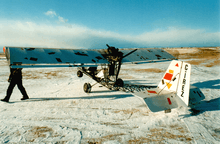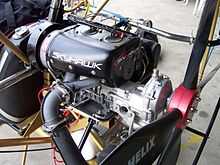Rotax 582
The Rotax 582 is a 48 kW (64 hp) two-stroke, two-cylinder, rotary intake valve, oil-in-fuel or oil injection pump, liquid-cooled, gear reduction-drive aircraft engine manufactured by BRP-Rotax GmbH & Co. KG. It is for use in non-certified aircraft operating in day visual flight rules.
Development
The Rotax 582 is based upon the earlier Rotax 532 engine design and was designed for use ultralight aircraft.[1][2] The 582 increased the bore from the 532 engine's 72 to 76 mm (2.8 to 3.0 in) and increased the stroke from 61 to 64 mm (2.4 to 2.5 in). This increased the displacement from 521.2 cc (31.81 cu in) to 580.7 cc (35.44 cu in), an increase of 11%. The increased displacement had the effect of flattening out the 532's torque curve and allowed the 582 to produce useful power over a wider rpm range. Reliability over the 532 was also improved.[2]
The 582 features liquid-cooled cylinder heads and cylinders with a Rotary Intake Valve. Cooling is via an externally-mounted radiator. Lubrication is either by use of pre-mixed fuel and oil or oil injection from an externally-mounted oil tank. The 582 has dual independent breakerless, magneto capacitor discharge ignition (CDI) systems and is equipped with two piston-type carburetors. It uses a manifold-driven pneumatic fuel pump to provide fuel pressure. An optional High Altitude Compensation kit is available.[1][2]
The engine's propeller drive is via a Rotax type B, C or E style gearbox. The standard engine includes a muffler exhaust system with an extra after-muffler as optional. The standard starter is a recoil start type, with an electric starter optional. An integral alternating current generator producing 170 watts at 12 volts with external rectifier-regulator is optional. The engine includes an intake air filter and can be fitted with an intake silencer system.[1][2]
Limitations
The manufacturer acknowledges the design limitations of this engine, warning pilots:[1]
"This engine, by its design, is subject to sudden stoppage. Engine stoppage can result in crash landings, forced landings or no power landings. Such crash landings can lead to serious bodily injury or death...This is not a certificated aircraft engine. It has not received any safety or durability testing, and conforms to no aircraft standards. It is for use in experimental, uncertificated aircraft and vehicles only in which an engine failure will not compromise safety. User assumes all risk of use, and acknowledges by his use that he knows this engine is subject to sudden stoppage...Never fly the aircraft equipped with this engine at locations, airspeeds, altitudes, or other circumstances from which a successful no-power landing cannot be made, after sudden engine stoppage. Aircraft equipped with this engine must only fly in DAYLIGHT VFR conditions."[1]
Applications



- Acrolite
- Advanced Aeromarine Buccaneer II
- Aero Adventure Aventura HP & Sport
- AeroLites AeroMaster AG
- AeroLites Bearcat
- Aeroprakt A-20
- Aeros-2
- Aeros Cross Country
- Aeros del Sur Manta
- Aerosette MH-46 Eclipse
- Aéro Services Guépard Guépe
- Airbet Girabet
- Airborne Edge
- Airborne Outback
- Airborne XT
- Air Command Commander Elite
- Air Creation GT
- Air Creation Racer
- Air Creation Skypper
- Air Creation Tanarg
- Airdrome Dream Fantasy Twin
- Airdrome Fokker DR-1
- Airkraft Sunny
- Airsport Sonet
- Alliant Destiny Fusion
- Alliant Destiny XLT
- Anglin J6 Karatoo
- Antares MA-32
- Antonov T-2M Maverick
- Apex Dolphin 3
- Apollo Delta Jet
- Apollo Fox
- Apollo Jet Star
- Apollo Monsoon
- Apollo Racer GT
- Aquilair Kid
- Aquilair Swing
- Arnet Pereyra Sabre II
- ASAP Chinook Plus II
- ASAP RX 550 Plus Beaver
- ATEC 212 Solo
- Australian Lightwing GR 582
- Aviasouz Cruise
- Aviasud Mistral
- Aviate Raptor
- Aviation Products Star Trike
- Avid Catalina
- Avid Flyer
- Avio Design Swan
- BAaer Guri
- BB Microlight BB-two seater
- Biplanes Of Yesteryear Mifyter
- Blue Yonder EZ Flyer
- Blue Yonder Merlin
- Brock KB-3
- Buckeye Endeavor
- Buzzman L'il Buzzard
- Capella XS
- Capella T-Raptor
- Carlson Sparrow
- Celier Kiss
- CFM Shadow
- Chernov Che-25
- Circa Reproductions Nieuport 12
- CGS Hawk
- Club ULM Rotor Ptenets-2
- Cosmos Phase II
- Cyclone AX2000
- DAR 21 Vector II
- DAR-23
- Denney Kitfox Model 2
- DTA Evolution
- DTA Feeling
- Earthstar Thunder Gull JT2
- Early Bird Jenny
- Ehroflug Coach II S
- Euro Fly Flash Light
- Eurofly Viper
- Excalibur Aircraft Excalibur
- Fantasy Air Allegro
- Fisher Classic
- Fisher Super Koala
- Fletcher Hercules
- Flightstar
- Flight Team Spider
- Fly Air Swallow
- Flying Machines FM301
- Flylab Tucano
- Fly Synthesis Catalina
- Fly Synthesis Wallaby
- FMP Qualt 201
- Freedom Lite SS-11 Skywatch
- FUL MA 30 Graffiti
- Gdecouv'R 582
- General Aviation Design Bureau T-32 Maverick
- Gidroplan Che-22 Korvet
- Gidroplan Tsikada
- Golden Circle Air T-Bird
- Guerpont Autoplum
- Harmening High Flyer
- Heldeberg Marathon
- Houde Speedmax
- Humbert La Moto Du Ciel
- Hy-Tek Hurricane Hauler
- InterPlane Skyboy
- J & J Ultralights Seawing
- Joplin Tundra
- Jora Jora
- Junkers Profly Junkers Trike
- Kolb Kolbra
- Kolb Mark III
- Kolb Slingshot
- Kolb Tandem
- Kompol Jazz
- Krasniye Kryl'ya Deltacraft MD-50C
- Laron Wizard
- Layzell Merlin
- Light Miniature Aircraft LM-1
- Light Miniature Aircraft LM-5
- Lockwood Drifter MU582
- Magni M-18 Spartan
- Mainair Blade
- Mainair Rapier
- Mariner Aircraft Mariner
- Masquito M58
- Micro Aviation B22 Bantam
- Microleve Corsario
- Microleve ML 450
- Microleve ML 500
- Moyes Dragonfly
- M-Squared Breese
- Murphy Maverick
- Murphy Renegade
- Nickel & Foucard NF-2 Asterix
- Norman Aviation J6 Karatoo
- Norman Aviation Nordic II
- North American Rotorwerks Pitbull SS
- North Wing Apache
- North Wing Sport X2
- Paladin Golden Eagle
- Para-Ski VX
- Para-Ski XS
- Peak Aerospace Me 109
- Pegasus Quantum
- Personal Flight Sky-Tender
- Phantom X1
- Pipistrel Spider
- Polaris AM-FIB
- Polaris FIB
- Polaris Skin
- Powrachute Pegasus
- PowerTrike Evolution
- PowerTrike II
- Precision Tech Fergy
- Quad City Challenger II
- Quander Airpfeil
- Quicksilver GT500
- Quicksilver Sport 2S
- Rainbow Aerotrike
- Rainbow Cheetah
- Raisner Graffiti
- Raj Hamsa X-Air
- Ramphos Trident
- Rans S-6 Coyote II
- Rans S-7 Courier
- Rans S-9 Chaos
- Rans S-10 Sakota
- Rans S-11 Pursuit
- Rans S-12 Airaile
- Revolution Mini-500 helicopter
- Rolandas Kalinauskas RK-6 Magic
- Schmidtler Enduro
- Sea and Sky Cygnet
- Sea-Bow International Sea-Bow
- Six Chuter SR1
- Six Chuter SR7
- Skyfly S-34 Skystar
- Skyrider Sonic
- Skyrider Stingray
- SlipStream Genesis
- Solo Wings Aquilla
- Sport Copter Vortex
- Skywatch SS11
- Spectrum Beaver RX 650
- Sport Flight Talon
- Summit 2
- Summit Steel Breeze
- S-Wing Swing
- TechProAviation Merlin 100
- TeST TST-6 Duo
- Thruster T600 Sprint
- Tiger Club Development Sherwood Ranger
- Titan Tornado
- TL Ultralight TL-32 Typhoon
- Vol Xerpa ULM Pulsar
- World Seair Corp Seair
- Y2Fly Seahawk
- Zenith STOL CH 701
Specifications (Rotax 582)

General characteristics
- Type: two-cylinder, two-stroke, rotary valve, oil-in-fuel or oil-injected lubrication, dual carburetors, electronic dual ignition
- Bore: 76 mm (2.99 in)
- Stroke: 64 mm (2.52 in)
- Displacement: 580.7 cm³ (35.44 cu in)
- Dry weight: 50 kg 110 lb with electric starter, carburetors, fuel pump, air filters and reduction gear
Components
- Fuel type: premium unleaded: RON 90 octane or higher leaded or unleaded or AVGAS 100 LL
- Oil system: oil-in-fuel (pre-mix) or oil injection
- Cooling system: liquid cooled
Performance
- Power output: 48 kW 64.4 HP SAE @ 6,500 RPM 1-minute
- Compression ratio: 11.5 (theoretical) - 5.75 effective
See also
- Rotax aircraft engines
- Arrow 500
References
External links
| Wikimedia Commons has media related to Rotax 582. |
| ||||||||
| ||||||||||||||